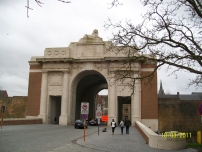| First Name: | William | Last Name: | DREDGE | |
|---|---|---|---|---|
| Date of Death: | 11/11/1914 | Lived/Born In: | Leyton | |
| Rank: | Corporal | Unit: | Oxford & Bucks Light Infantry2 | |
| Memorial Site: | Menin Gate, Ypres | |||
Current Information:Born & Enlisted-Reading
First Battle of Ypres Between 21st October and 22nd November, 1914 a desperate fight took place around the Belgium city of Ypres, the first of three major battles that were to be fought there during the course of the war. British troops entered Ypres in October. The 1st and 2nd Divisions plus the 3rd Cavalry Division had made their way up from the Aisne as part of the “Race to the Sea”, whilst the 7th Division came west to Ypres after Antwerp had fallen. The Germans knew that Ypres was the gateway to the Channel ports and that these were vital to Britain’s war effort so they poured reinforcements into the area. The fighting fell into three distinct battles; the Battle of Langemarck, 21-24 October, the Battle of Gheluvelt, 29-31 October and the Battle of Nonne Bosschen, 11 November. Ypres did not fall to the Germans but its defence during these two months resulted in the destruction of much of the old regular British Army. The battle of Nonne Bosschen The battle of Nonne Bosschen on 11th November, 1914 was the final German attempt to break through the British lines around Ypres. They threw twelve and a half divisions into an attack against a nine mile front, stretching from Messines to Reutel (close to Polygon Wood). The main thrust of their attack was either side of the Menin Road where two fresh divisions, numbering around 10,000 men were sent against eleven tired and depleted British divisions of around 4000 men. The attack was launched at 9 am after the heaviest artillery barrage yet seen and was protected by early morning mist. Astride the Menin Road the defenders were forced to give ground but more critical was the attack that penetrated the Guards Brigade line just to the north and allowed the Germans to get into Nonne Bosschen woods and threaten the artillery line. This threat was averted in the afternoon when a counter attack cleared the Germans from the wood. There was now no chance of a breakthrough and although the Germans made a few minor attacks over the next few days the First Battle of Ypres was finished. On 11th November, the 2nd Oxford & Bucks Light Infantry battalion of 5 Brigade, 2nd Division were the reserve battalion of 2nd Division and in position at Westhoek behind Nonne Bosschen Wood. At 2 pm, when news reached them that the Germans had penetrated the wood, two companies from the battalion moved into it from the north-west, with the other two companies following in support. One company of 1st Northamptonshire co-operated from Glencorse Wood in the west whilst at the same time, 5th Field Company of the Royal Engineers charged south over open ground between Nonne Bosschen and Polygon Wood. 2nd Oxford & Bucks Light Infantry moved swiftly through the wood killing or capturing any of the enemy who resisted. Most fled and as they emerged from the wood they were hit by the fire of 1st Northamptonshire and 1st Cameron Highlanders in Glencorse Wood. They paused at the edge of the wood and then, joined by 1st Northamptonshire and the Royal Engineers, moved forward to retake the old support trenches. The Germans either fled or surrendered. So taken by surprise were the enemy that 2nd Oxford & Bucks Light Infantry suffered only a few casualties, one of whom was William Dredge.
|
||||
| « Back to Search Results | ||||
| If you think any of the information shown here is incorrect, Click Here to submit your amends and comments | ||||




